Americans felt pretty good about themselves in 1913. The economy was stable, Woodrow Wilson was inaugurated for his first term and even the institution of the income tax which had been strongly opposed by the wealthy enjoyed the general support of the population. Wilson symbolically completed the Panama Canal by telegraphically setting off a charge of dynamite which demolished the Gamboa dike and connected the oceans.
1913 The first prize package
Perhaps even more important – if you were a kid in 1913 – was the brainstorm of an executive for a struggling company called Cracker Jacks who thought it might improve the company’s dismal sales if they inserted a small toy in each box of the product. Henry Ford also had a thought – why not a “moving” assembly line? By the end of 1913 a car was rolling out of the plant every two and a half minutes. The first crossword puzzle appeared in a newspaper in 1913; Oregon enacted the first minimum wage law and Death Valley set a still unbroken temperature record of 134 degrees.
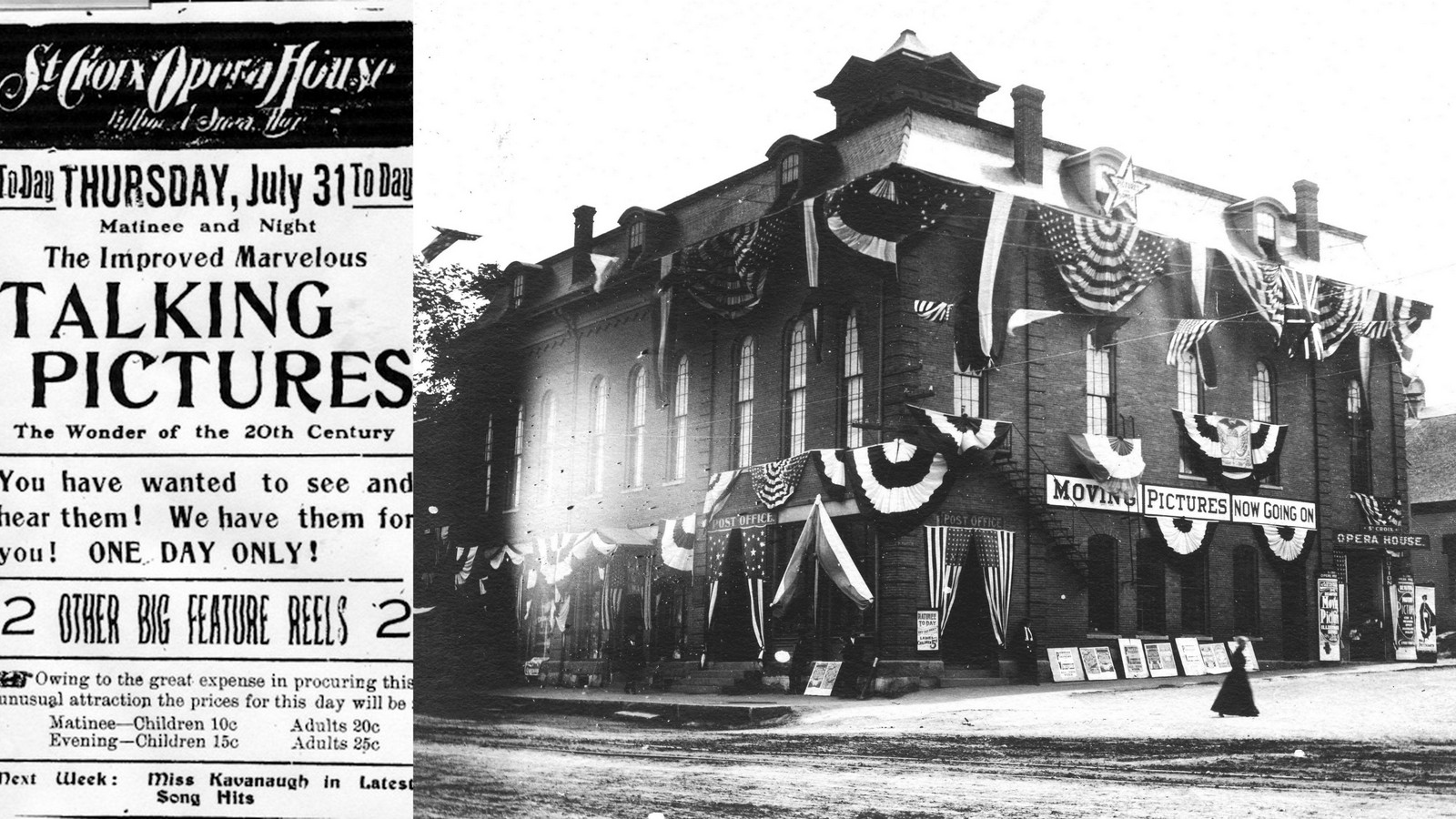
1913 the “Talkies” were a bust. Opera House Calais, corner Main and Church
Kansas passed a law allowing the state to censor a scandalous new form of entertainment, motion pictures but the Opera House in Calais was by 1913 exhibiting not only motion pictures but “talkies”. The first motion pictures were not of good quality but improved rapidly and eventually included sound. The pictures advertised in the ad are talkies but not the sort we know today. Attempts to synchronize the sound to the video were not very successful as the gramophone which contained the soundtrack was connected to the projector by a series of pulleys which nearly always failed to work. It was the 1920s before the sound and audio track were combined on the same medium.
In the early years of “movies” the best part of the show was often the piano player. Each movie scene was accompanied by a piano score which was played by a pianist in the theater while the scene was on the screen. The pianists were always locals and some of them were very talented. The best ones were in high demand and there was a good deal of competition among theaters for their services.
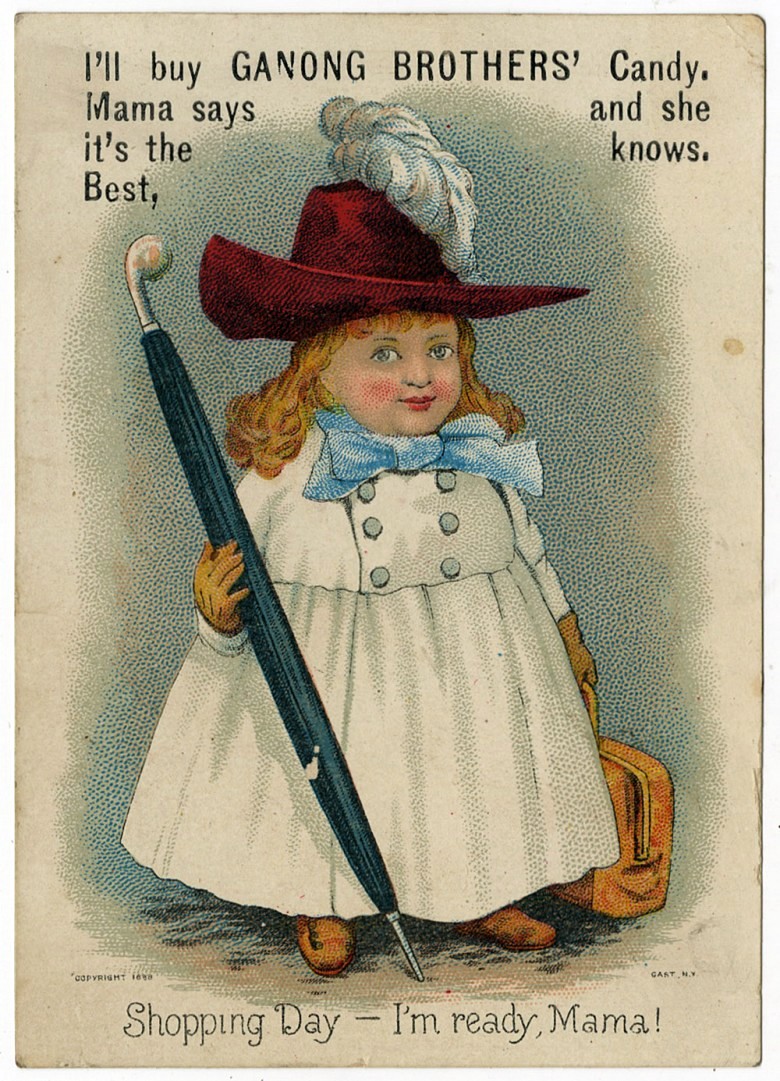
In the St Croix Valley, the Advertiser reported that business was booming. Many new operations were hiring including the Fertilizer Plant in St Stephen. Existing businesses such as Ganongs, Calais Box, Haley’s and the Woodland Mill were all enjoying banner years. According to the Advertiser “The outlook for the coming year is bright and promising.” The Advertiser carried full page ads for trips on the “California Limited” to the “Rim of that World Wonder, the Grand Canyon of Arizona.”
Birds were also in the news- a common tern banded in Maine and found in South Africa was the first instance of a bird crossing the Atlantic. A respectable Calais citizen, Alice Osborne found herself in breach of Federal laws against the importation of the feathers of tropical birds when she landed in Boston from Liverpool wearing a hat containing pheasant feathers. The feathers were confiscated. In contrast the Bangor Daily reported in April of 1913 that Superintendent Bradley of the Maine Water Department had spied a rare Arctic owl in Meddybemps and promptly shot it, stuffed it and the bird was “on exhibition in the Maine Water Co’s office and is attracting considerable attention.”
In the rest of the world the situation was less rosy. Mexico was in turmoil as its President was assassinated and 3000 people killed in 10 days in Mexico City during the uprising. Pancho Villa and others went to war against the new regime and Mexico was not to see any stability until the 1920’s. Men from this area served with General Pershing in his unsuccessful pursuit of Pancho Villa which only ended when Pershing’s troops were needed to fight in Europe.
In Europe agreement among Greece, Bulgaria, Serbia, Turkey and others finally ended the Balkan War but the war soon had to be renamed the 1st Balkan War as the 2nd Balkan War broke out almost immediately and necessitated a second London Conference and settlement which lasted, as we know, only until August of 1914 when the war engulfed not only the Balkans but all of Europe.
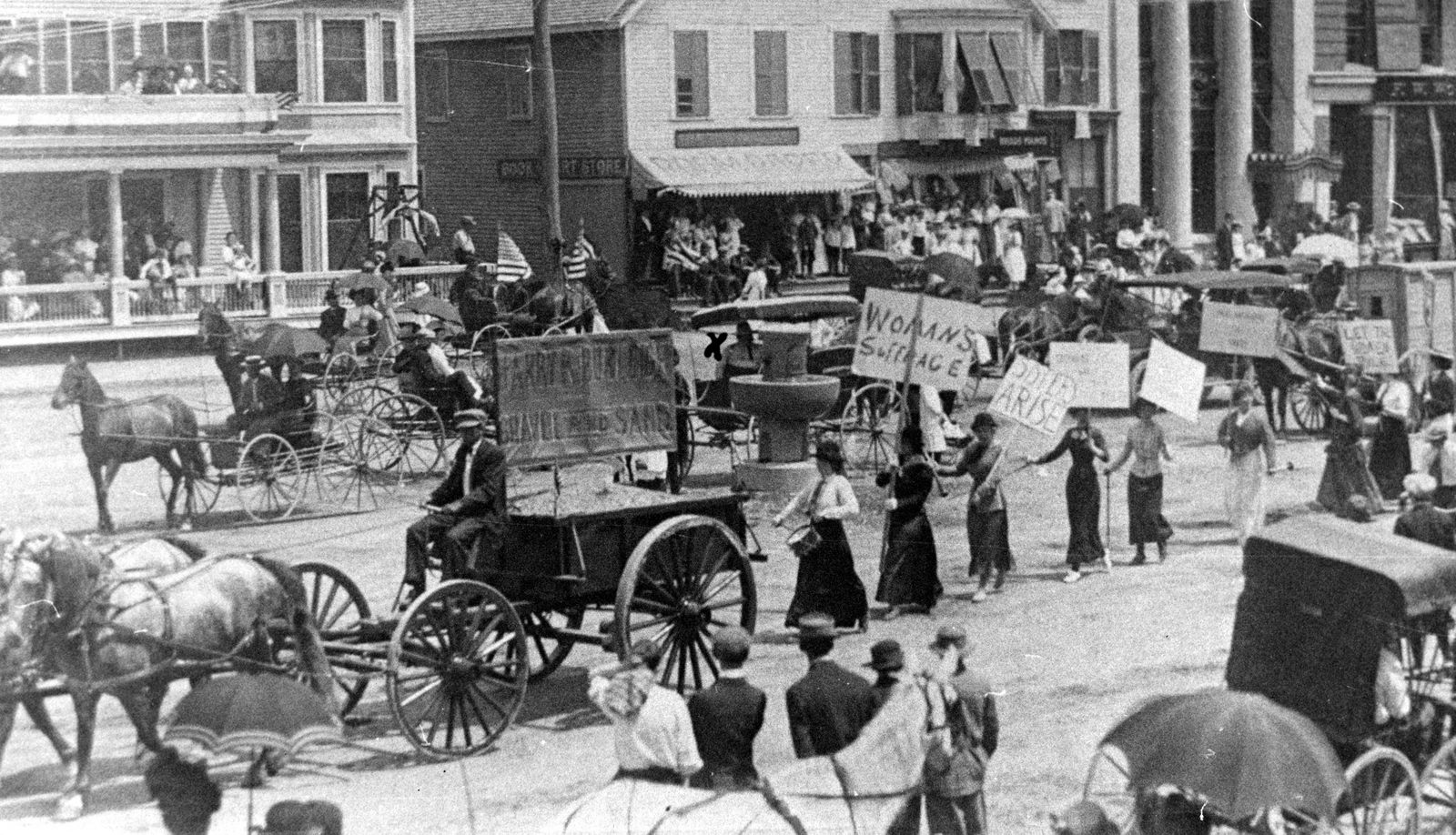
Suffragette march said to be Calais but probably not. Could be Houlton?
The English were at wits end about how to deal with a determined suffragette movement led by Sylvia Pankhurst who, when locked up for 90 days for throwing a brick through a bank window during a demonstration, went on a hunger strike. The government miscalculated public opinion when they force fed the resisting Pankhurst by clamping her mouth open with a steel vice and forced food down her throat. Even those who were not sympathetic to the cause thought this unsporting and protests only mounted. The Calais Advertiser supported the right of women to vote and Alice Murchie Eaton of Princeton, a woman highly respected in the St. Croix Valley, was also a strong advocate and crusader for universal suffrage. It was to be many years, however, before women cast their first ballot.
In other 1913 political news the Pittsburgh Press of March 19th and other national newspapers reported that Peter Ranco of the Penobscot Tribe and Peter J. Newell of the Passamaquoddy Tribe were seated in the Maine House Of Representatives. While it seemed progress of sorts, the article went to say:
Although neither has an official seat in the House of Representatives there are two unoccupied seats in the rear of the house which they fill for a time during their sojourn. They have no vote and no voice in legislative matters, yet they are legally elected members and during the period of their attendance do a considerable amount of work.
In fact, it was to be several decades before tribal members were allowed to vote in state elections even though they were to be subject to the draft in the Great War which was to begin in a year and the Second World War. In both conflicts tribal members served with great distinction.
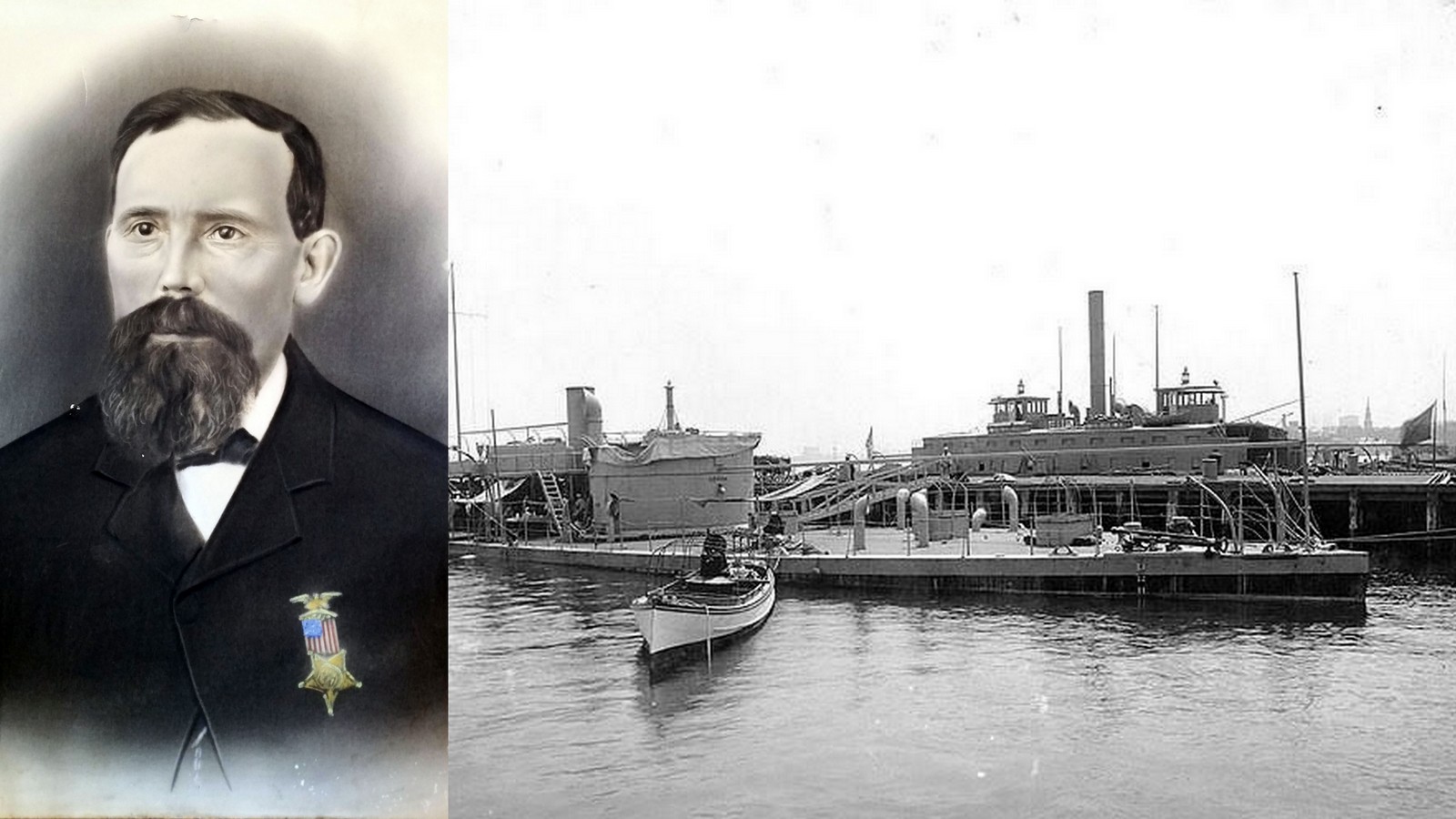
The Lehigh was still afloat for the Spanish American War 1898
On July 3rd, 1913 Horatio Nelson Young, the only local man to win the Congressional Medal of Honor died in Red Beach. Historical and news accounts of his exploits give his birthplace as Calais but this is not correct. He was born just across the border in Dufferin (The Ledge) New Brunswick on July 19, 1843. Like many New Brunswickers he sought the excitement and adventure offered by our Civil War and like most got far more of both than he bargained for.
In Young’s case it was in Charleston Harbor South Carolina where the Union vessel U.S.S. Lehigh on which Young was serving was stranded on a sandbar in the harbor directly under the Confederate’s coastal guns. The Lehigh was taking a fearful pounding and was unlikely to survive much longer. Nearby but out of range of the Confederate guns was the Union vessel Nahant. Young and some other sailors launched a small boat from the Lehigh and under intense fire from the batteries managed to carry a line to the Nahant. Young’s citation reads as follows:
On board the USS Lehigh, Charleston Harbor, 16 November 1863, during the hazardous task of freeing the Lehigh, which had grounded, and was under heavy enemy fire from Fort Moultrie. After several previous attempts had been made, Young succeeded in passing a small boat from the Lehigh to the Nahant with a line bent on a hawser. His courageous action while under severe enemy fire enabled the Lehigh to be freed from her helpless position.
After the war Young settled in Brooklyn, New York where he raised a family. He is listed on official records as an engineer. According to his obituary in the Standard Union of Brooklyn July 5, 1913 he had lived in Red Beach for many years before his death. He was survived by his wife Mary and was predeceased by his son Horatio Nelson Young, Jr. in Brooklyn less than a month before he died in Red Beach. He is buried in the St. Stephen Cemetery.
Another local hero of the Civil War also buried in the St. Stephen cemetery, John Curtis Caldwell, was principal of Washington Academy in East Machias and became a brigadier general during the Civil War. He commanded a division at Gettysburg. He was one of eight generals to accompany Lincoln’s body from Washington D.C. to Lincoln’s home in Springfield, Illinois. Caldwell died in Calais while visiting his sister who had married a Calais Murchie. By family tradition the Murchies, who were a wealthy lumber family on both sides of the border, were put to final rest in the spacious Murchie lot at the St. Stephen Cemetery. Even though General Caldwell was not a Murchie, he had little say in the matter and joined Horatio Young across the line.
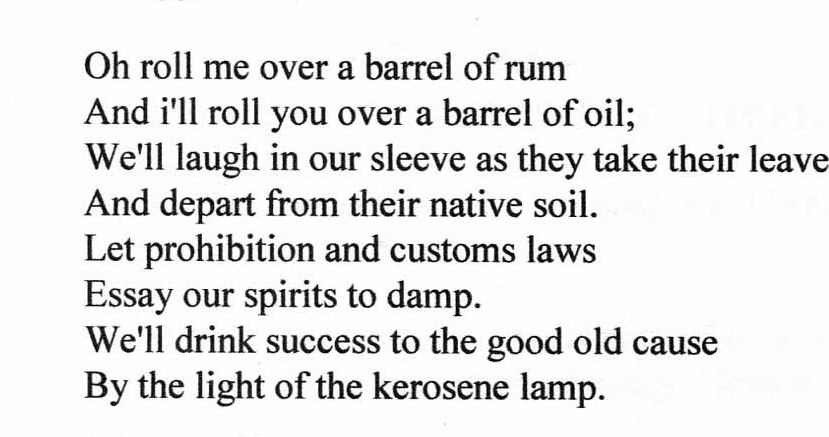
Famous local ditty
One of the most important business concerns in 1913 was bootlegging and smuggling. In April of 1913 the Washington County Sheriff spent a couple of days in Augusta trying to explain to the Governor why he should not join four other county sheriff in impeachment proceedings for failure to enforce prohibition. The Sheriff explained that the law required he seize liquor sold illegally but the liquor coming into Washington County had, in fact, been sold legally to Canadians who were then smuggling it back across the river and bay. It was, he said, a Customs enforcement issue, and not up to local law enforcement.
In the “odd” news of 1913 there was the local opposition to a proposed “pop factory” opening in Calais. A local resident protested in the Advertiser:
“ Well for the love of Mike what does Calais or any other town want with a pop factory? Pop is about the most useless beverage that ever moistened the throat of a man. It’s nothing but water with something put in to spoil the water. It is water fooled with till it wont quench thirst and is spoiled for washing baby clothes. The steady drinking of pop will cause a man’s liver to grow white and make him afraid to go home in the dark!”
In odd and tragic news of 1913 Stephen Diffin of Robbinston drowned as a result of a wager with two other teenagers over who could stay underwater longest with a chew of tobacco in his mouth. Stephen never resurfaced, apparently strangling on the tobacco. 1913 saw its usual quota of railroad fatalities – Lula Ahern and her son Daniel of Baileyville were killed instantly at the Baring railroad crossing when struck by the express from Bangor and 7-year-old Alice McClure, daughter of a railroad employee in Baileyville, died after being struck by the “cow catcher” of the Princeton train.
In odd 1913 political news a bill was introduced in Congress to fund a project to divert the Gulf Stream to sweep up the East coast of the United States rather than sliding over to Europe. As far we know this remains a work in progress although Mother Nature seems to be making some alterations lately without congressional approval.
Finally the Calais Advertiser of November 5, 1913 reported the death of Herbert W. Eaton, ne’er do well son the lumber baron J. Emerson Eaton. We have written extensively about Herb in the past. In the 1880s after a bout of heavy drinking he shot dead a friend and severely injured his brother. He fled to Canada and missed six times while trying to shoot himself in Truro Nova Scotia. The family worked a plea deal and Herbert returned to face justice in Machias where he paid a thousand dollar fine. He never did spend even one day in jail. He travel extensively around the world, was nearly lynched in Africa for shooting sacred birds and generally lived a life free of the cares and worries of ordinary folk.

